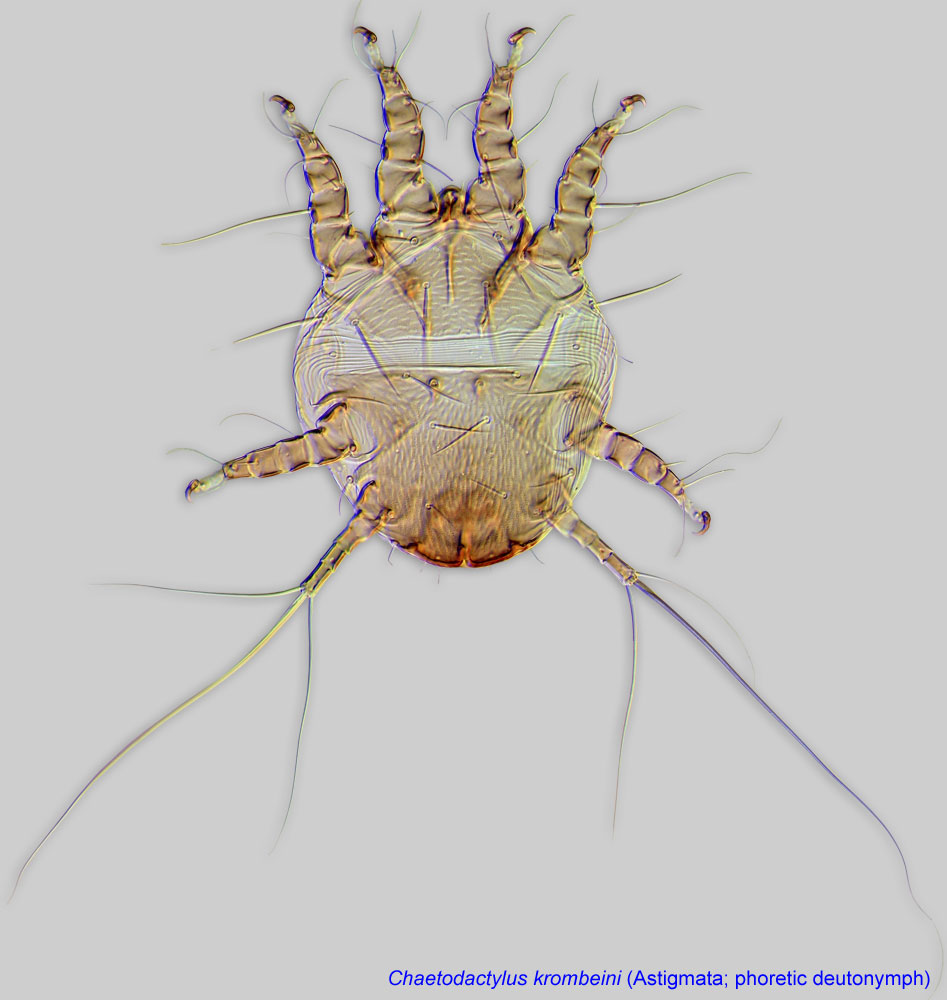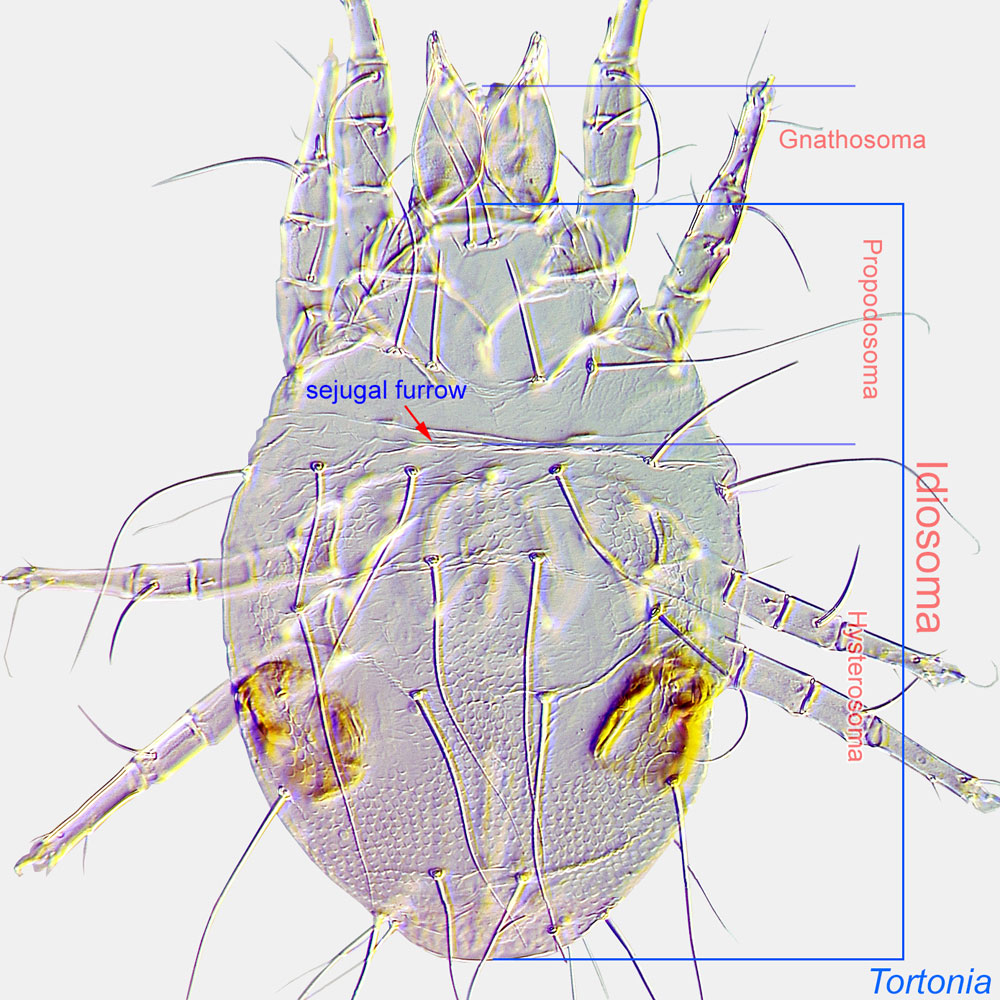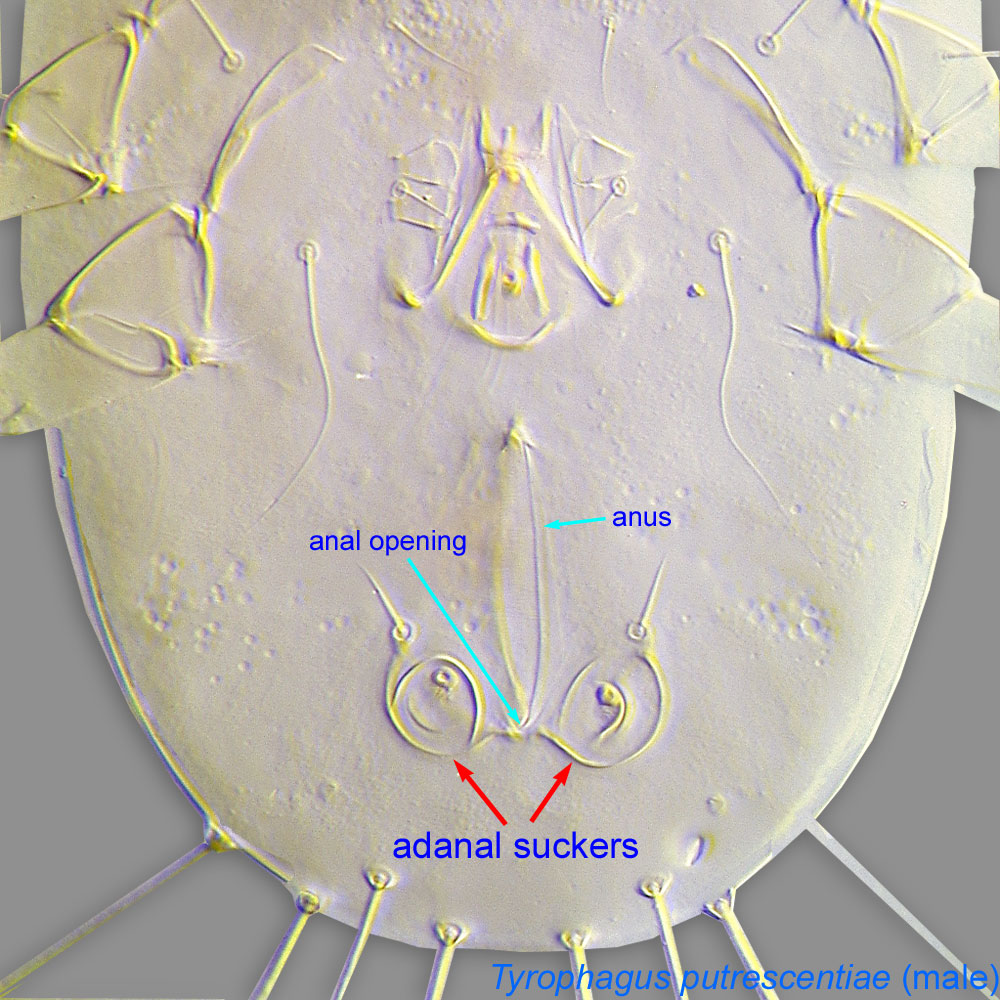predominantly mutualistic; feed on waste of bee larvae, probably outweighing small harmful effect of feeding on pollen; bee hosts have acarinariaacarinarium:
A specialized morphological structure that facilitates retention of mites on the body of an organism, typically a bee or wasp.
to transfer mites
Ctenocolletacarus Fain, 1984Fain, 1984:
Fain, A. 1984. Notes sur les hypopes du genre Horstia Oudemans, 1905 (Acari, Acaridae), phoretiques sur les hymenopteres. Acarologia . 25 : 259-270.
Superorder Acariformes » Order Sarcoptiformes » Suborder Oribatida » Infraorder Desmonomata » Hyporder Astigmata » Family Acaridae » Genus Ctenocolletacarus
Ctenocolletacarus longirostris Fain, 1984Fain, 1984:
Fain, A. 1984. Notes sur les hypopes du genre Horstia Oudemans, 1905 (Acari, Acaridae), phoretiques sur les hymenopteres. Acarologia . 25 : 259-270.
In the literature Ctenocolletacarus is treated as a valid genus. However, its adults are indistinguishable from Sancassania and its phoreticphoretic:
Pertaining to phoresy; using another organism (i.e., a host) for dispersal to new habitats. Phoresy can be distinguished from parasitism because feeding typically does not occur during phoresy.
deutonymphsdeutonymph:
Ontogenetic stage between protonymph and tritonymph (or adult, if tritonymph is absent). See <a href="index.cfm?pageID=1720">Life stages page</a> for more details. have only autapomorphic (unique) diagnostic character states, suggesting that Ctenocolletacarus is part of Sancassania rather than an independent, genus-level lineage.
have only autapomorphic (unique) diagnostic character states, suggesting that Ctenocolletacarus is part of Sancassania rather than an independent, genus-level lineage.
Phoretic phoretic:
Pertaining to phoresy; using another organism (i.e., a host) for dispersal to new habitats. Phoresy can be distinguished from parasitism because feeding typically does not occur during phoresy.
deutonymph: Rostrumrostrum:
In the Oribatida, the anteriormost dorsal portion of the idiosoma; in the Prostigmata (Cheyletoidea), the subcapitulum or the gnathosomal capsule.
enlarged (Fig. 1). IdiosomaIdiosoma:
Body not including the gnathosoma.
 transversely striated (Fig. 1).
transversely striated (Fig. 1).
Adults: No adanal suckersadanal sucker:
Paired pad-like structures situated near the anal opening in males of Astigmata. Originate from adanal setae. Serve for holding female during copulation. Also known as anal suckers and paranal suckers.
 in males. Heteromorphic males unknown.
in males. Heteromorphic males unknown.
See Sancassania for other characters.
The three described species can be identified using keys to phoreticphoretic:
Pertaining to phoresy; using another organism (i.e., a host) for dispersal to new habitats. Phoresy can be distinguished from parasitism because feeding typically does not occur during phoresy.
deutonymphsdeutonymph:
Ontogenetic stage between protonymph and tritonymph (or adult, if tritonymph is absent). See <a href="index.cfm?pageID=1720">Life stages page</a> for more details. in Fain, 1984bFain, 1984b:
in Fain, 1984bFain, 1984b:
Fain, A. 1984b. A new genus of mite (Acari: Acaridae) phoretic on bees ( Ctenocolletes ) in Australia. Records of the Western Australian Museum . 11 : 77-86. and in the bee-associated mites website. Adults are known only from one species, Ctenocolletacarus longirostris, described in Fain and Houston, 1986Fain and Houston, 1986:
Fain, A. amp; T. F. Houston. 1986. Life cycle stages of mites of the genus Ctenocolletacarus Fain (Acari: Acaridae) associated with Ctenocolletes bees in Australia. Records of the Western Australian Museum . 13 : 67-77..
Phoretic phoretic:
Pertaining to phoresy; using another organism (i.e., a host) for dispersal to new habitats. Phoresy can be distinguished from parasitism because feeding typically does not occur during phoresy.
deutonymphsdeutonymph:
Ontogenetic stage between protonymph and tritonymph (or adult, if tritonymph is absent). See <a href="index.cfm?pageID=1720">Life stages page</a> for more details. of Ctenocolletacarus can be distinguished from those of Sancassania by the enlarged rostrumrostrum:
of Ctenocolletacarus can be distinguished from those of Sancassania by the enlarged rostrumrostrum:
In the Oribatida, the anteriormost dorsal portion of the idiosoma; in the Prostigmata (Cheyletoidea), the subcapitulum or the gnathosomal capsule.
(not enlarged in Sancassania) and the transversely striated idiosomaidiosoma:
Body not including the gnathosoma.
 (not striated on Sancassania). Males of Ctenocolletacarus lack adanal suckersadanal sucker:
(not striated on Sancassania). Males of Ctenocolletacarus lack adanal suckersadanal sucker:
Paired pad-like structures situated near the anal opening in males of Astigmata. Originate from adanal setae. Serve for holding female during copulation. Also known as anal suckers and paranal suckers.
 (present in the majority of Sancassania species).
(present in the majority of Sancassania species).
Australia
ground-nesting bees of the genus Ctenocolletes (Stenotritidae)
permanentpermanent:
associated exclusively with bees or their close relative, wasps; cannot live without these hosts
 are immobile and non-feeding.
are immobile and non-feeding. disperse in the tergal acarinariaacarinarium:
disperse in the tergal acarinariaacarinarium:Observational data indicate that this bee-mite system is a tradeoff between mites being harmful to the bee when they feed on provisioned pollen and beneficial when they consume waste of developing bee larvae in the nest. The presence of acarinariaacarinarium:
A specialized morphological structure that facilitates retention of mites on the body of an organism, typically a bee or wasp.
on bees suggests predominantly beneficial (mutualistic) bee-mite relationships in this system. Most likely, consuming a small portion of pollen in the brood cell and competing with bee larvae for food have a lesser deleterious effect, as compared to the benefits of the mite's sanitary function.
Detailed biological observations of Ctenocolletacarus mites in bee nests of Ctenocolletes albomarginatus and Ctenocolletes nicholsoni and in the laboratory are available in Houston, 1987Houston, 1987:
Houston, T. F. 1987. The symbiosis of acarid mites, genus Ctenocolletacarus (Acarina: Acariformes), and stenotritid bees, genus Ctenocolletes (Insecta: Hymenoptera). Australian Journal of Zoology . 35 : 459-468..
These mites are closely associated with their hosts at all stages and their complete life cycle occurs in the hosts' sealed brood cells. Only phoreticphoretic:
Pertaining to phoresy; using another organism (i.e., a host) for dispersal to new habitats. Phoresy can be distinguished from parasitism because feeding typically does not occur during phoresy.
deutonymphsdeutonymph:
Ontogenetic stage between protonymph and tritonymph (or adult, if tritonymph is absent). See <a href="index.cfm?pageID=1720">Life stages page</a> for more details. leave the cells.
leave the cells.
Male bees lack tergal acarinariaacarinarium:
A specialized morphological structure that facilitates retention of mites on the body of an organism, typically a bee or wasp.
, so mite phoreticphoretic:
Pertaining to phoresy; using another organism (i.e., a host) for dispersal to new habitats. Phoresy can be distinguished from parasitism because feeding typically does not occur during phoresy.
deutonymphsdeutonymph:
Ontogenetic stage between protonymph and tritonymph (or adult, if tritonymph is absent). See <a href="index.cfm?pageID=1720">Life stages page</a> for more details. on male bees are usually concealed beneath the transparent posterolateral margins of the more posterior metasomal terga and in the genitalia. Circumstantial evidence suggestis that mite phoreticphoretic:
on male bees are usually concealed beneath the transparent posterolateral margins of the more posterior metasomal terga and in the genitalia. Circumstantial evidence suggestis that mite phoreticphoretic:
Pertaining to phoresy; using another organism (i.e., a host) for dispersal to new habitats. Phoresy can be distinguished from parasitism because feeding typically does not occur during phoresy.
deutonymphsdeutonymph:
Ontogenetic stage between protonymph and tritonymph (or adult, if tritonymph is absent). See <a href="index.cfm?pageID=1720">Life stages page</a> for more details. can be transmitted venereally between adult bees.
can be transmitted venereally between adult bees.